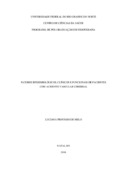Please use this identifier to cite or link to this item:
https://repositorio.ufrn.br/handle/123456789/22536| Title: | Fatores epidemiológicos, clínicos e funcionais de pacientes com acidente vascular cerebral |
| Authors: | Melo, Luciana Protásio de |
| Advisor: | Campos, Tânia Fernandes |
| Keywords: | AVC;Vigilância em saúde pública;Epidemiologia;Independência funcional;Fisioterapia |
| Issue Date: | 29-Nov-2016 |
| Citation: | MELO, Luciana Protásio de. Fatores epidemiológicos, clínicos e funcionais de pacientes com acidente vascular cerebral. 2016. 161f. Tese (Doutorado em Fisioterapia) - Centro de Ciências da Saúde, Universidade Federal do Rio Grande do Norte, Natal, 2016. |
| Portuguese Abstract: | O Acidente Vascular Cerebral (AVC) é um importante problema de saúde pública, por isso foi realizado um estudo com o objetivo de avaliar os fatores epidemiológicos, clínicos e funcionais de pacientes com AVC. Participaram do estudo 433 pacientes (229 mulheres e 204 homens). Em Natal/RN, os pacientes foram avaliados através do Step 1 e Escala de Rankin Modificada. Os dados foram analisados pelo teste Qui-quadrado e análise de regressão logística. Resultados: Verificou-se maior frequência de pacientes na faixa etária de 70 a 89 anos (40,9%). A hipertensão arterial foi o fator de risco mais frequente (85,4%) e o AVC isquêmico (68,5%). Foi observada maior frequência de pacientes com incapacidade de andar e realizar higiene pessoal (48,8%) (p= 0,001). Observou-se uma correlação entre o grau de comprometimento neurológico e a funcionalidade (r= 0,53; p= 0,006). Considerando as atividades básicas da vida diária (ABVDs), 25% dos pacientes não podiam levantar da cama e 70,8% não conseguiam ir ao banheiro sozinhos (ambos p< 0.05). Os modelos de regressão apontaram os fatores preditores da dependência funcional para as atividades: "banho", quantidade de fatores de risco (OR=0,4; IC=0,2-0,7; p=0,005) e quantidade de medicação usada previamente ao AVC (OR=1,7; IC=1,1-27; p=0,013). Para "higiene pessoal", realização de Fisioterapia após a alta (OR=2,5; IC=1,2-5,1; p=0,014) e sexo feminino (OR=1,6; IC=1,06-2,4; p=0,026); para "transferência", quantidade de fatores de risco (OR=0,4; IC=0,2-0,9; p=0,025); para "continência", tipo de AVC (OR=2,2; IC=1,1-3,8; p=0,003 – 10º dia; OR=1,9; IC=1,1-3,3; p=0,013 – 28º dia) e realização de Fisioterapia após a alta (OR=4,1; IC=1,5-11,3; p=0,005); e para atividade "alimentação", quantidade de AVC prévio (OR=0,5; IC=0,2-0,9; p=0,036) e realização de Fisioterapia após a alta (OR=4,2; IC=1,6-11,1; p=0,003). Para as seis atividades, a idade acima de 60 anos e a falta de realização da fisioterapia durante a internação hospitalar foram os mais fortes fatores preditivos para a dependência funcional. Os resultados indicam fatores importantes que influenciam a dependência funcional dos pacientes com AVC, trazem uma contribuição científica para que os prestadores de saúde possam identificar oportunidades de intervenção e apontam a necessidade urgente de implantação de Unidades de AVC no Estado Rio Grande do Norte. |
| Abstract: | Stroke is an important public health problem, thus one study was carried out with the aim to evaluate epidemiological, clinical and functional factors of stroke patients. Materials and Methods: Four hundred thirty-three patients participated in the study (229 women and 204 men). In Natal/RN, the patients were assessed through the Step 1 and the Modified Rankin Scale. The data were analysed through the chi-squared test and logistic regression analysis. Results: It was noticed that the higher frequency of patients were in the age range of 70 to 89 years (40,9%). Arterial hypertension was the most frequent risk factor (85,4%) as well as the ischemic stroke (68,5%). There was a higher frequency of patients with incapacity to walk and do their personal hygiene (48,8%) (p= 0,001). It was also observed a correlation between the degree of neurological impairment and functionality (r= 0,53; p= 0,006). Regarding the basic activities of daily living (BADL), 25% of the patients could not rise from bed and 70,8% could not go to bathroom on their own (both p< 0.05). The regression models pointed out to the predictive factors of functional dependence to the activities: “bathing”, quantity of risk factors (OR=0,4; IC=0,2-0,7; p=0,005) and quantity of medication used prior to stroke (OR=1,7; IC=1,1-27; p=0,013). To “personal hygiene”, attendance to physiotherapy after discharge (OR=2,5; IC=1,2-5,1; p=0,014) and female sex (OR=1,6; IC=1,06-2,4; p=0,026); to “transfer”, quantity of risk factors (OR=0,4; IC=0,2-0,9; p=0,025); to “continence”, type of stroke (OR=2,2; IC=1,1-3,8; p=0,003 – day 10; OR=1,9; IC=1,1- 3,3; p=0,013 – day 28) and attendance to physiotherapy after discharge (OR=4,1; IC=1,5-11,3; p=0,005); and to the activity “eating”, frequency of stroke (OR=0,5; IC=0,2-0,9; p=0,036) and attendance to physiotherapy after discharge (OR=4,2; IC=1,6- 11,1; p=0,003). To the six activities, age above 60 years and nonattendance to physiotherapy during hospital stay were the strongest predictive factors for functional dependence. Conclusion: The results indicate important factors that affect the functional dependence of stroke patients, thus bringing about a scientific contribution so that the healthcare providers may identify opportunities of intervention; they also point out the urgent need of implanting a Stroke Unit in the state of Rio Grande do Norte. |
| URI: | https://repositorio.ufrn.br/jspui/handle/123456789/22536 |
| Appears in Collections: | PPGFS - Doutorado em Fisioterapia |
Files in This Item:
| File | Description | Size | Format | |
|---|---|---|---|---|
| LucianaProtasioDeMelo_TESE.pdf | 3,22 MB | Adobe PDF |  View/Open |
Items in DSpace are protected by copyright, with all rights reserved, unless otherwise indicated.

